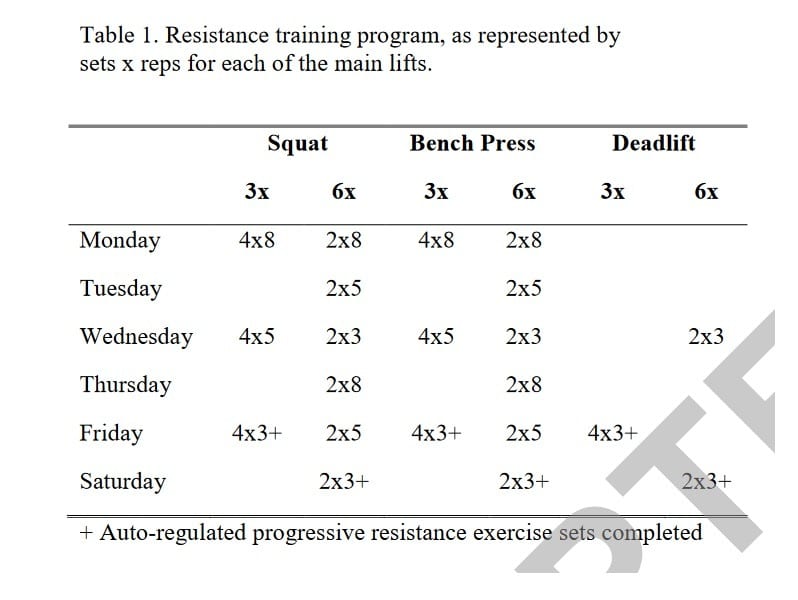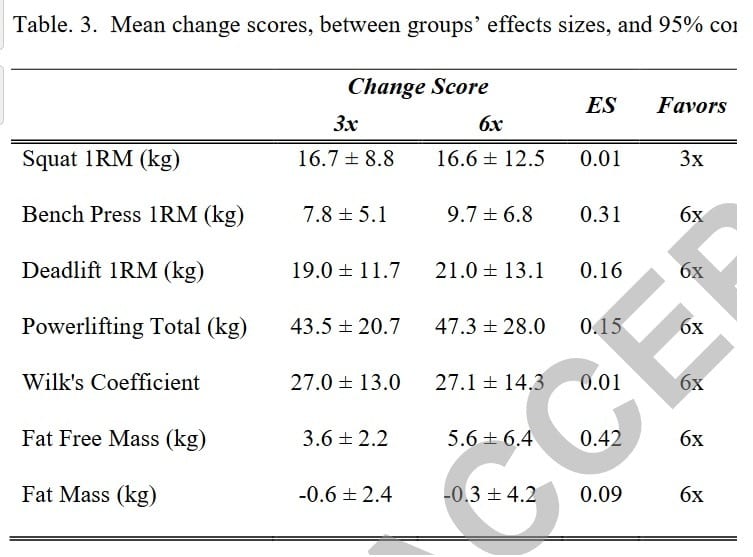New training frequency study: 3x vs. 6x
The Norwegian Frequency Project is a once-secret-now-famous study in which the Norwegian Powerlifting team participated to study the ideal training frequency of each muscle group. They found that splitting the same program up into 6 instead of 3 full-body workouts led to better strength development and muscle growth. These results caused massive controversy at a time the bro bodybuilding community was mostly still training each muscle once a week with bro splits.
A new study has now essentially replicated the Norwegian Frequency Project. 28 Male college students were put on a Powerlifting program split up over either 3 or 6 workouts. The participants were legitimately intermediate level trainees. The strength training programs were equated for training volume, intensity and time: the 6x group performed the same exercises with the same weights and reps but with 2 instead of 4 sets per exercise per session.

The results: There were no statistically significant differences in strength progression or muscle growth. However, no power analysis was performed. With 28 participants and a 6-week study, statistical power was probably too low to find statistically significant differences for small or moderate differences. So the authors calculated the effect sizes for each outcome. These are displayed below.

As you can see, the effect sizes favored the 6x group for the bench press and the deadlift but interestingly not the squat. The differences are small, however. The only effect size difference that really stands out is that for fat-free mass, considerably favoring the 6x group. This suggests better muscle growth in the group training each muscle 6x per week.
These results trend in the same direction as the Norwegian Frequency Project, but the differences between groups were less pronounced. It’s plausible that the benefits of very high frequency training are largely limited to advanced trainees. Indeed, every study so far that has found benefits of very high training frequencies (6+x per week) was performed on Powerlifters, Olympic Weightlifters or athletes. Theoretically, women are also expected to handle higher training frequencies better than men. This study only included men. The Norwegian Frequency Project also included women.
It is important to note that the vast majority of research, including this new study, employs training volume equated programs between the different training frequencies. While this study noted they used autoregulated progressive overload, this is largely incompatible with their claim that the training sets, repetitions and intensities were equated between groups. In practice, if you perform 2 sets twice a week compared to 4 sets once a week you will almost certainly achieve more repetitions with the higher training frequency, because you’ll spend less time training in a fatigued state. As such, this study, and the literature in general, does not take into account what may be the greatest benefit of higher training frequencies: being able to easily accumulate more high quality training volume. There’s little doubt among evidence-based fitness professionals that total training volume is one of the most important determinants of the results of a strength training program.
Conclusion: Intermediate male trainees achieve the same or slightly better strength development and muscle growth if they train each muscle group 6x compared to 3x per week, even if they don’t allow themselves to perform more repetitions with the higher training frequency. For the average trainee that doesn’t want to train that often, rest assured that you can certainly achieve good progression already with ‘just’ 3 full-body workouts per week.
Want a research review of every topic related to strength training or nutrition? Have a look at your online PT Course.
Study reference: Training Volume, Not Frequency, Indicative of Maximal Strength Adaptations to Resistance Training. Colquhoun RJ, Gai CM, Aguilar D, Bove D, Dolan J, Vargas A, Couvillion K, Jenkins NDM, Campbell BI. J Strength Cond Res. 2018 Jan 5. doi: 10.1519/JSC.0000000000002414.
 Want more content like this?
Want more content like this?
Then get our free mini-course on muscle building, fat loss and strength.
By filling in your details you consent with our privacy policy and the way we handle your personal data.
